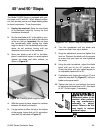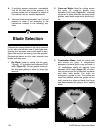
-38- G1022 Series Contractor Saws
Ripping
Ripping means to cut with the grain of the wood.
In other materials such as MDF or plywood, rip-
ping simply means to cut lengthwise. To rip a
board:
1. Inspect the board for soundness. You will
need a straight edge to rip with accuracy and
safety. Your workpiece may need to be joint-
ed flat before attempting to cut on the table
saw.
2. Set the rip fence to the desired distance from
the blade. IF YOU ARE MAKING NARROW
CUTS, USE A PUSH STICK. It is unsafe to
put your hands close to the blade. A push
stick pattern has been included in this man-
ual on Page 62, or you can purchase the
G3445 or G1411 push stick from the Grizzly
catalog. Use them to hold the workpiece
against the table and fence, and push the
workpiece fully past the blade. When a small
width is to be ripped and a push stick can-
not be safely put between the blade and rip
fence, rip a larger piece to obtain the desired
piece.
3. Turn on the saw and allow it to reach full
speed. Place the trued edge of the board
against the rip fence. Feed the workpiece
slowly and evenly into the blade. Do not
stand behind the board as shown in Figure
56.
Figure 56. Do not stand directly behind wood.
Stand out of the line of potential kickback.
Hold the workpiece firmly against the fence
and table. Do not allow your fingers to get
close to the blade! Do not reach over the
blade to off-load the workpiece.
Never attempt to rip a board that does not
have one perfectly straight edge on it.
Always run the straight edge of the board
against the rip fence. Failure to do this
could result in kickback and serious per-
sonal injury.
Figure 55. Cross-cut operation.


















